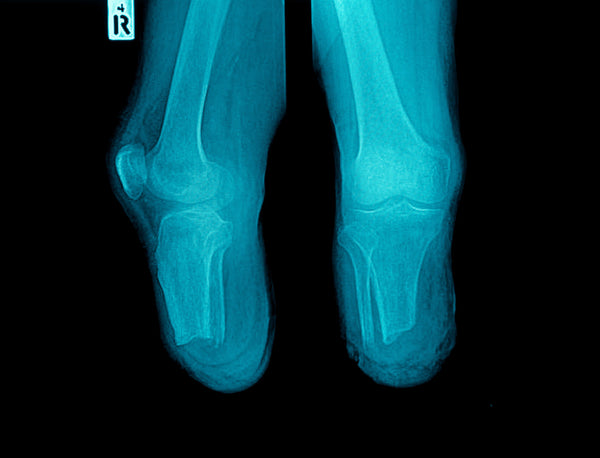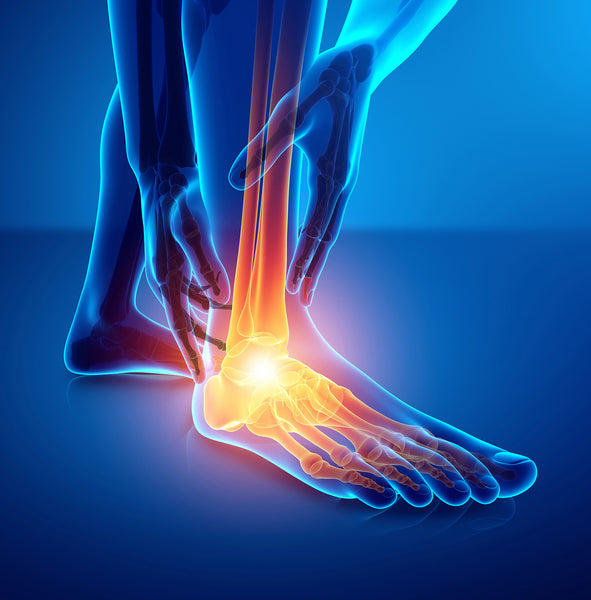Leg Injury Resource Center
Welcome to the Leg Injury Resource Center

An ankle sprain is an injury caused to the ligaments that connect and surround the bones of the legs and the foot. Ankle sprain injuries are caused when there is an accidental twisting or turning of the ankle in an awkward way. This leads to the over stretching and tearing of the ligaments keeping together your joints and bones, and results in a sprain.
There is a specific range of motion for each ligament in the human body. This allows the ligaments to keep the joints in a stable position. If these ligaments surrounding your ankle are pushed beyond their limits, a sprain in one of these ligaments is caused which can be very painful. Most of the ankle sprains are caused due to injury to the ligaments present on the outside of the foot.
Ankle sprains are a common injury of the ankle and can be extremely painful and very complex. An ankle sprain may not look like a serious injury at first, but it is not the case most of the time. Even a small ankle sprain can lead to the tightness of the muscles in your calf, a decrease in the coordination, and can even lead to arthritis of the joints.
It is important to understand the causes, symptoms and treatment options for sprained ankles so you can take an informed decision in case you are faced with a sprained ankle. It is important to call the doctor right away if you think you have sprained your ankle. The severity of the sprain will be determined by the doctor and they will advise you about the proper course of treatment. A sprained ankle may take weeks to months to completely heal.
Read about Ankle Sprain Causes, Symptoms, Diagnosis, Treatment and Recovery Here
Below Knee Amputation
Causes, Surgery and Rehabilitation
Below the Knee Amputation- An Overview
There are nearly thirty to forty thousand amputations performed in the US annually and 1.8 million Americans are living with amputations. The most common amputations are the below knee amputations, of which 23% are lower limb amputations. Individuals aged 65 and above are the main recipients of the below knee amputations.
Amputations are a life changing event. The goal of a below knee amputation is to remove the unhealthy and damaged tissues and make the remaining leg more useful and less painful. It is a reconstruction surgery and aims to bring the patient back to normal life. A below knee amputation is usually performed for ankle and foot issues.
To read about Below Knee Amputation Causes, Surgery and Rehabilitation click here
Broken Ankle
Causes, Symptoms, Diagnosis, Treatment and Recovery
A broken ankle, also commonly known as ankle fracture, is one of the most common joint and bone injuries. It is caused when one or more of the bones making up the ankle joints are broken. It can range from a simple break in one of these bones caused due to excessive walking, or several fractures causing the ankle to go out of place. It can also be accompanied with damage to the ligaments which hold the joint and ankle bones in place. Broken ankles can happen to anyone regardless of their gender, age or their athletic ability.
Types of Ankle Injury
The ankle injuries can occur in any part of the ankle including:
-
The tibia
-
The fibula
-
The talus
For information about Broken Ankle Causes, Symptoms, Diagnosis, Treatment and Recovery Click Here
Bunions
Causes, Symptoms, Treatment and Recovery
Bunions – An Overview
A bunion is a progressive deformity of the metatarsophalangeal joint in the foot. This joint connects your big toe to your foot. This joint helps in distributing your body weight equally on all parts of the foot while you are standing, running or walking. A bunion is the result of when the bones of the foot are pushed into a shape that is not natural. The base of the big toe protrudes outwards, and the big toe points towards the other toes. This condition is known as the hallux valgus deformity. If there is excess pressure exerted on the joint, it can lead to the enlargement of the inside of the foot. It can also affect the outside of the foot as well.
Small bunions usually go unnoticed as they are not painful. However, the bunions that result in pain are accompanied with other symptoms and problems such as the swelling of the foot’s soft tissues along with tenderness, pain, redness and swelling in the affected area. The pain is often relieved after resting, however, it can lead to chronic pain in the big foot if it develops into arthritis.
For more information on Bunions, Causes, Symptoms, Treatments and Recovery click here
CRPS of the Lower Leg and Foot
CRPS, abbreviation for Complex Regional Pain Syndrome, is a condition that affects the foot and the legs. Also known as Reflex Sympathetic Dystrophy, it is a complex multi system and excruciating chronic disease of the central nervous system and the autonomic nervous system. This disease causes constant pain and is said to be as excruciating as conducting a finger amputation without anesthesia. It is often diagnosed too late to recover fully and is devastating for the patients.
CRPS – An Overview
CRPS is a neuro-inflammatory disease of chronic nature. It can happen in any part of the body but affects one or both limbs in most of the cases. In CRPS, the immune and nervous system of the patient’s body malfunction to respond to tissue damage, caused from an injury or trauma. This causes the nerves to misfire, and the connections become faulty which leaves the affected areas in constant acute pain. In most of the cases, there is an abnormal response of the central nervous system and the immune system of the affected patient’s body which makes the injury even worse and causes severe pain.
The level of pain varies from person to person. It can cause physical and visual inconsistencies, and the amount of trauma caused to the body due to CRPS also varies from patient to patient. Unfortunately, not many people are aware of CRPS. A lot of research is still underway on the disease, its causes and how it can be treated.
For more information on CRPS Causes, Symptoms, Treatment and Recovery Options Click Here.
Foot Fracture and Broken Foot
Foot Fracture-An Overview
Feet are very vulnerable to twisting and slipping because of the high frequency of their use. A broken foot, also known as a foot fracture, is a very common injury. In fact, one fracture out of every ten broken bones is in the foot. A fracture in the foot can be the result of either chronic overuse or a sudden trauma. Regardless of the cause of the fracture in the foot, it can be a serious injury and can take a long time to recover fully before the person can take on the normal routine activities again. To make the best treatment and rehabilitation choices, it is important to have knowledge about the different fractures in the foot, their causes, symptoms and the best treatment and rehabilitation options available.
For more information on Foot Fractures, Causes, Symptoms, Treatment and Recovery Click Here
Fractures of the Fibula
Causes, Symptoms, Treatment Options and Recovery
Fibula Bone – An Overview
Fibula and tibia are the main bones of the lower leg. These are two of the four long bones of the body. The fibula is the small bone, also known as the calf bone located on the outside of the leg while the tibia, also known as the shin bone, is located on the inside of the lower leg. Tibia and fibula join at the ankle and the knee and help support and stabilize the lower leg and ankle muscles. Fibula, because of its small size, is prone to breaking. The main function of the fibula is to provide support to the tibia. This exerts a force on it and, therefore, stress fractures of the fibula are a common occurrence.
The term fibula fracture is used to describe a break in the fibula, a bone in the lower leg. It usually results in conjunction with a broken ankle or a fracture of the tibia. Fibula fracture results from a forceful impact such as falling, landing on the foot after a high jump, or an impact to the outer leg. Spraining your ankle and rolling it can also cause a fracture in the fibula. Fractures of the fibula are common among athletes.
For more information on Fractures of the Fibula, Causes, Symptoms, Treatment Options and Recovery Click Here
Jones Fracture
Jones Fracture – An Overview
A Jones Fracture is a common fracture of the fifth metatarsal of the foot. While there are other kinds of fractures that can occur in the metatarsals, Jones fracture is the most common and much more severe than the rest. It is characterized by a break in the area where the base of the metatarsal connects with the shaft of the smallest toe.
A Jones fracture, named after Sir Robert Jones, is a break between the shaft and base of the fifth metatarsal of the foot. Based on its location, it is also commonly known as the fracture of the fifth metatarsal. The fifth metatarsal is located on the outside of the foot and is connected to the smallest toe. It is the most common type of fracture of the metatarsals. Jones fractures are common among athletes and can be caused by stress to or overuse of this area located in the middle of the foot. It may be mistaken for a sprain, but it is much more severe than that.
For more information on Jones Fracture Causes, Symptoms, Treatment and Recovery Click Here
Lisfranc Injury
Lisfranc Injury – An Overview
Lisfranc injuries are named after Dr. Jacques Lisfranc, who worked on the dislocations, sprains and fractures of the mid-foot--the place at the junction of the upper and lower foot bones. To be precise, Lisfranc injury is caused when there is a damage to the joints where the thin metatarsals meet the tarsal bones, making up the midfoot. The midfoot region is the area where the metatarsals extend to the toes. Each joint and bone in the midfoot has a specialized job and provides support to the foot while walking, running and standing. Injuries to the midfoot can range from dislocated and broken bones to torn ligaments.
Lisfranc injuries are often thought to be foot sprains, especially when the injury occurs due to some obvious causes like falling from a height or twisting the foot. It is important to keep in mind that a Lisfranc injury is not the same as an ankle or foot sprain. It can also not be walked off to reduce the pain, swelling and other symptoms. It can take several months for the Lisfranc injury to heal and may even require a surgical procedure if the injury to the foot is severe.
For more information about Lisfranc Injury Causes, Symptoms, Treatment and Recovery Click Here.
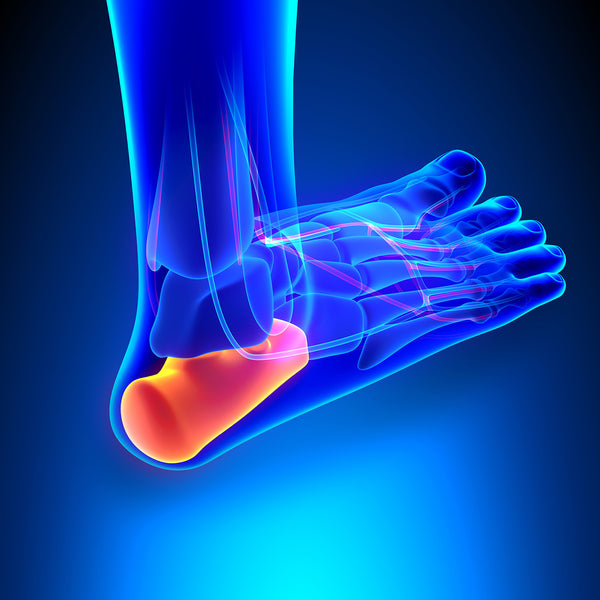
Plantar Fasciitis
Plantar Fasciitis – An Overview
Plantar fasciitis is the inflammation of your plantar fascia. Plantar fascia is a strong and thick band of tissues stretching from the heel to the bones of the middle foot. It provides support to the arch of your foot and also play the role of a shock absorber for your foot. Inflammation of the plantar fascia can be a painful condition and if left untreated, can cause serious problems for the foot. The symptoms of plantar fasciitis are worst when you wake up in the morning.
Plantar fasciitis, named after plantar fascia (toes), is one of the most common causes of heel pain. 1 in every 10 people is affected by plantar fasciitis at least once in their lives. It is common among people between the age group 40-60. It is caused by an inflammation in a thick band of tissues running across the bottom of the foot. This band of tissues connects your heel bone and toes. It is a common occurrence among runners and in people who are overweight. It is also more common among women than in men. Also, wearing shoes with inadequate support pose an increased risk of getting affected from plantar fasciitis.
For more information about Plantar Fasciitis Causes, Symptoms, Treatment and Recovery Click Here.
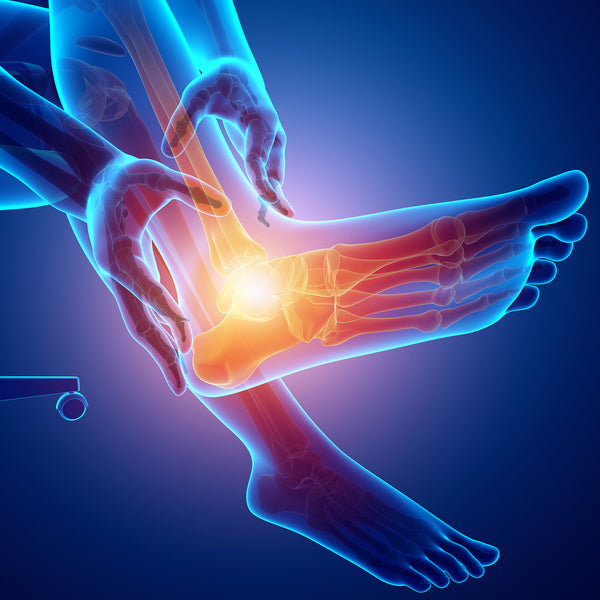
Stress Fractures of the Foot and Ankle
Most of the cases of stress fractures of the foot and ankle are reported in the 2nd and 3rd metatarsals which are thinner than the other metatarsals and the navicular. Stress fractures are mostly overuse injuries. They are caused when there are repetitive forces resulting in microscopic damage to the ankle or foot bones. These repetitive forces are not strong enough to cause a complete fracture. Stress fractures occur when an athletic movement is repeated so often that the weight bearing bones on the foot are unable to heal between the exercise sessions.
Bones are in a constant turnover state, known as remodeling. This means that a new bone replaces the older and worn out bone. In case of a repeated vigorous physical activity, the breakdown of the bones occurs rapidly but there is not enough time available to the body to repair or replace the worn-out bone. This leads to the weakening of the bones and they become vulnerable to stress fractures.
For more information about Stress Fractures of the Foot and Ankle Causes, Symptoms, Treatment and Recovery Click Here.
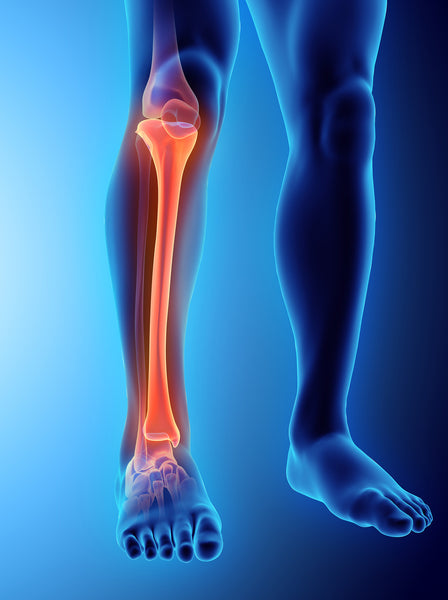
Tibial Fracture
Tibia – An Overview
Tibia, also commonly known as the shinbone, runs between the length of your shin between the ankle and the knee. It can be felt when you run your hand on the front of your leg. It is one of the most commonly injured bones in the body because of its excessive use in all the activities a person does. Fractures of the tibia can be really painful and can lead to months of recovery where you are not allowed to put any weight on your injured leg. In severe cases, you may also have to undergo a surgery to treat the fracture in case it is beyond repair through the non-surgical treatment methods.
Tibia, one of the longest bones of the body is also the one that is most commonly fractured. It can be fractured as a result of a trauma and can result in bruising accompanied with intense pain in the lower leg. A fracture to the tibia can take a variety of forms and can involve long periods of inactivity and immobility. It might also include a long recovery time, depending on the extent of damage caused to the bone. The doctor will advise a surgical or a non-surgical treatment based on the severity of the fracture.
For more information on Tibial Fracture Causes, Symptoms, Diagnosis and Treatment Click Here.
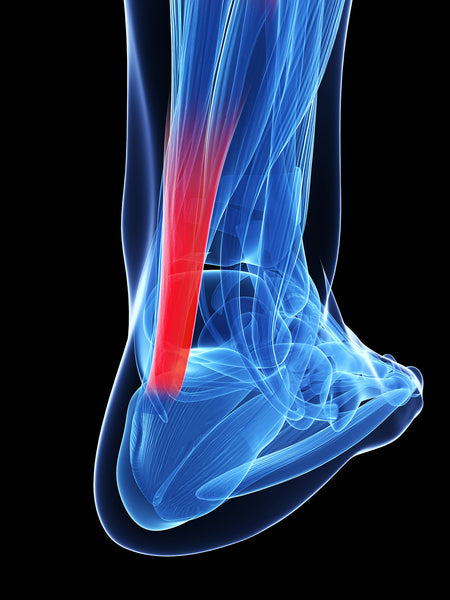
Achilles Tendon Rupture
Achilles Tendon Rupture – An Overview
An Achilles tendon rupture is an injury that most commonly occurs when playing recreational sports. It affects the back of your leg and is caused when the complete Achilles tendon ruptures as a result of a sudden or forceful action during an intense physical activity. When your Achilles tendon ruptures, you might feel a snap or a pop which is followed by a sharp pain in the lower leg and the back of your ankle. The best treatment option for an Achilles tendon rupture is surgery, however, there are other non-surgical treatments as well that work in many cases.
An Achilles tendon rupture is most common among male athletes in their middle age (the weekend warriors who engage in a pickup game of football for example). It usually occurs while playing recreational sports that require bursts of running, pivoting and jumping, such as badminton, basketball, tennis and racquetball.
For more information on Achilles Tendon Rupture Causes, Symptoms and Treatment Click Here.
We hope you find our Lower Leg Injury Resource Center helpful. Please remember this is just for informational purposes and you should consult your doctor for medical advice and treatment options.
Looking for a knee scooter or knee walker? Whether you are looking for a knee scooter rental or a knee scooter for sale, we have the best option for you. Purchasing a knee scooter can be more cost effective than renting a knee scooter. Can't find a knee scooter near me? We offer free next day shipping!

